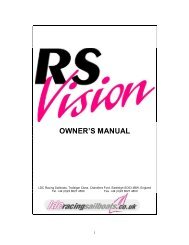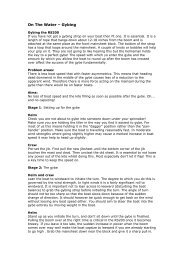rs200 owner's manual - Rs Sailing
rs200 owner's manual - Rs Sailing
rs200 owner's manual - Rs Sailing
You also want an ePaper? Increase the reach of your titles
YUMPU automatically turns print PDFs into web optimized ePapers that Google loves.
Sail Care Guide<br />
By Hyde Sails<br />
Good racing sails today are expensive items, yet it is surprising how many<br />
people are prepared to neglect or mistreat them. The rules for correct sail<br />
care are easy and simple to implement.<br />
1. The jib and mainsail should be stored dry, out of direct sunlight when not in<br />
use (Ultra-Violet light damages sailcloth), and rolled:<br />
* Ensure there are no folds in the cloth as you roll the sail.<br />
* If you do have a fold or crease, unroll the sail and let the crease drop out.<br />
DO NOT PULL IT OUT!! This action can tear sailcloth.<br />
2. Asymmetric spinnakers should be stored dry and loose if possible, do not<br />
leave them in the chute with the corners hanging out! Do not dry spinnakers<br />
by allowing them to flap in the wind.<br />
3. When using brand new sails for the first time, try to ensure that the<br />
conditions are not too extreme because the high loads on new sailcloth can<br />
diminish the racing life of the sail. This particularly applies to the Hard Dacron<br />
jib which may get a lot of those 'Little white score marks'. Do not allow sails to<br />
flap unnecessarily. Where possible, take sails down between races and as<br />
soon as possible after sailing.<br />
4. If your sail is stained in any way, try to remove it using normal detergent<br />
and warm water. Do not attempt to launder the sail yourself.<br />
6. Repairs should be temporarily fixed using sticky number cloth or sail repair<br />
tape and then returned to a sailmaker for a professional repair.<br />
7. Check the batten tension regularly, slack battens can work their way out of<br />
the luff retaining caps and damage the sailcloth. The battens should be<br />
tensioned enough in the pockets so that when the boat is sailing there are no<br />
wrinkles in the batten pockets. Watch out for wear and tear, especially<br />
around the batten pockets and bolt rope.<br />
8. Make sure that all shackles, pins and sharp objects that the spinnaker<br />
might travel over are well taped (preferably using PVC tape). Untaped<br />
shackles or frayed wires are the most common cause of major tears in<br />
spinnakers.<br />
20




